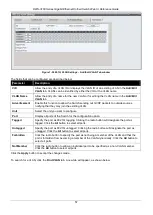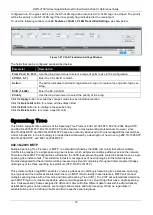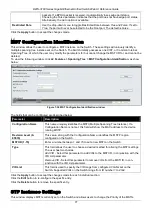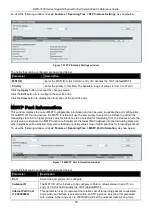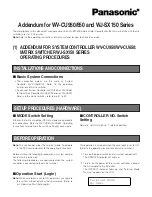
DWS-3160 Series Gigabit Ethernet Unified Switch Web UI Reference Guide
63
GVRP
The GARP VLAN Registration Protocol (GVRP) enables the port to dynamically
become a member of a VLAN. GVRP is
Disabled
by default.
Ingress Checking
This drop-down menu allows the user to enable the port to compare the VID tag of
an incoming packet with the port VLAN membership. If enable ingress checking
and the reception port is not the member port of the frame’s VLAN, the frame shall
be discarded.
Acceptable Frame Type
This field denotes the type of frame that will be accepted by the port. The user may
choose between
Tagged Only
, which means only VLAN tagged frames will be
accepted, and
All
, which mean both tagged and untagged frames will be accepted.
All
is enabled by default.
Click the
Apply
button to accept the changes made.
MAC-based VLAN Settings
Users can create new MAC-based VLAN entries, search and delete existing entries. When a static MAC-based
VLAN entry is created for a user, the traffic from this user will be able to be serviced under the specified VLAN.
To view the following window, click
L2 Features > VLAN > MAC-based VLAN Settings
, as show below:
Figure 7-13 MAC-based VLAN Settings
The fields that can be configured are described below:
Parameter
Description
MAC Address
Specify the MAC address.
VID (1-4094)
Select this option and enter the VLAN ID.
VLAN Name
Select this option and enter the VLAN name of a previously configured VLAN.
Click the
Find
button to locate a specific entry based on the information entered.
Click the
Add
button to add a new entry based on the information entered.
Click the
View All
button to display all the existing entries.
Click the
Delete All
button to remove all the entries listed.
Click the
Delete
button to remove the specific entry.
Private VLAN Settings
A private VLAN is comprised of a primary VLAN, up to one isolated VLAN, and a number of community VLANs. A
private VLAN ID is presented by the VLAN ID of the primary VLAN. The command used to associate or de-
associate a secondary VLAN with a primary VLAN.
A secondary VLAN cannot be associated with multiple primary VLANs. The untagged member port of the primary
VLAN is named as the promiscuous port. The tagged member port of the primary VLAN is named as the trunk port.
A promiscuous port of a private VLAN cannot be promiscuous port of other private VLANs. The primary VLAN
member port cannot be a secondary VLAN member at the same time, or vice versa. A secondary VLAN can only
have the untagged member port. The member port of a secondary VLAN cannot be member port of other
secondary VLAN at the same time. When a VLAN is associated with a primary VLAN as the secondary VLAN, the
promiscuous port of the primary VLAN will behave as the untagged member of the secondary VLAN, and the trunk









